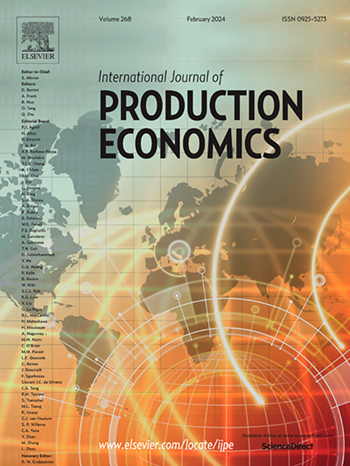A sustainable semiconductor supply chain under regulation
IF 9.8
1区 工程技术
Q1 ENGINEERING, INDUSTRIAL
引用次数: 0
Abstract
Modern life would not exist without semiconductors as all electronic components used in computers, telecommunications, health care, transportation, and energy systems are equipped with chips. To examine both backward and forward activities in semiconductor industry, this paper formulates the industry as a closed-loop supply chain. It articulates how old semiconductors are processed and recycled to manufacture new silicon and chips, and examines the impact of a commonly applied subsidy scheme on the performance of semiconductor firms which operate in upstream and downstream layers of the industry. Specifically, the proposed semiconductor supply chain involves (i) a return function sensitive to monetary incentives; (ii) a subsidy legislation rewarding end-users for recycling; (iii) upstream industry where silicon is produced using virgin and scrap materials; (iv) downstream industry in which semiconductor manufacturers (such as TSMC, Samsung, Intel) buy silicon and other materials, hire workers, and then produce and sell chips. We characterize Stackelberg equilibrium silicon and semiconductor prices and outputs and calibrate model parameters using actual data to quantify the effects of subsidy and collection channels on silicon and semiconductor firms’ performance. We find that the subsidy scheme neither distorts firms’ strategies nor causes any inefficiency for the semiconductor industry. It stimulates circular economy activities and provides economic and environmental benefits.
监管下的可持续半导体供应链
现代生活离不开半导体,因为计算机、电信、医疗保健、交通和能源系统中使用的所有电子元件都装有芯片。为了研究半导体行业的后向和前向活动,本文将该行业表述为一个闭环供应链。本文阐述了旧半导体如何通过加工和回收来制造新的硅片和芯片,并研究了一项普遍适用的补贴计划对半导体行业上下游企业绩效的影响。具体而言,拟议的半导体供应链涉及:(i) 对货币激励敏感的回报函数;(ii) 奖励终端用户回收利用的补贴立法;(iii) 利用原始材料和废料生产硅的上游产业;(iv) 半导体制造商(如台积电、三星、英特尔)购买硅和其他材料、雇佣工人,然后生产和销售芯片的下游产业。我们描述了 Stackelberg 平衡硅和半导体价格与产出的特征,并利用实际数据对模型参数进行了校准,以量化补贴和征收渠道对硅和半导体企业绩效的影响。我们发现,补贴计划既没有扭曲企业的战略,也没有导致半导体行业效率低下。它刺激了循环经济活动,带来了经济和环境效益。
本文章由计算机程序翻译,如有差异,请以英文原文为准。
求助全文
约1分钟内获得全文
求助全文
来源期刊
CiteScore
21.40
自引率
7.50%
发文量
266
审稿时长
52 days
期刊介绍:
The International Journal of Production Economics focuses on the interface between engineering and management. It covers all aspects of manufacturing and process industries, as well as production in general. The journal is interdisciplinary, considering activities throughout the product life cycle and material flow cycle. It aims to disseminate knowledge for improving industrial practice and strengthening the theoretical base for decision making. The journal serves as a forum for exchanging ideas and presenting new developments in theory and application, combining academic standards with practical value for industrial applications.

 求助内容:
求助内容: 应助结果提醒方式:
应助结果提醒方式:


